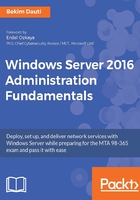
Understanding server hardware and software (5.1)
In general, computer hardware is any physical component regardless of the material that it is made of, such as metal, plastic, or wood. On the other hand, software is the instruction or program that tells hardware what to do. It is a virtual component which we have no physical contact with and is represented by the OS, programs, utilities, and any other type of software. When talking about the server's hardware and software, the computer definition of hardware and software applies to servers as well. However, as already explained, because servers provide network services, more powerful hardware is required. At the same time, the software is different too. For example, Windows Server 2016 is different to Windows 10 although both are Microsoft's products.
Now that we have explained the concepts of hardware and software, the following points outline the hardware components that affect the overall performance of your servers, thus you should not make any compromises when you want to build or buy, and set up a server.
- Processor: A chip on a server's motherboard, often called the computer's brain, that does all the processing and calculations. Intel and AMD are the well-known processor manufacturers. The newest processors on the market are 64-bit architecture compared to the old ones of 32-bit.
- RAM: Stands for Random Access Memory (RAM). It is a working memory used by your server's OS and applications. The more RAM you have in your servers, the more applications you can run simultaneously.
- Disk: This is where you store data on your servers. Usually servers have more than one disk known as a server's disk sub-system. The higher the read-and-write speed, the higher the performance of your disk system.
- Network interface: Provides a network connection in and out of your servers. Usually servers have more than one network interface. The higher the speed of your server's network connection, the faster the server can send and receive data over the network.
Concerning the size and form factors, servers come in three formats:
- Rack mountable servers: These are traditional big servers that are mounted on a rack
- Blade servers: These are usually small modules known as blades that are mounted on a server's chassis to save space.
- Tower servers: These are single servers that stand upright.
Running Windows Server 64-bit on 64-bit hardware means double the amount of data is being processed by the processor and sent between the processor and the RAM when compared to Windows Server 32-bit running on 32-bit hardware.